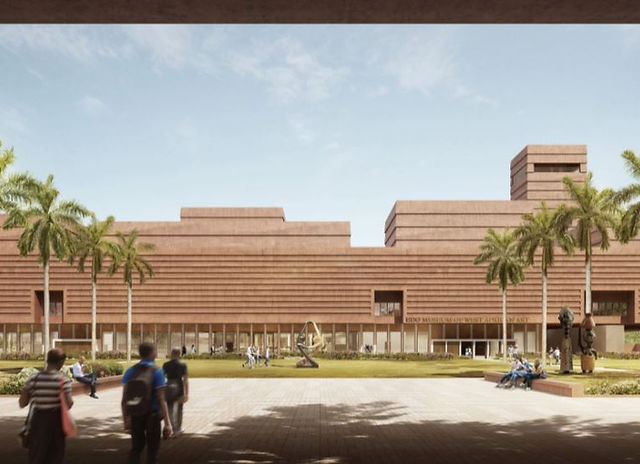By Isaac Aimurie
As countries continue to seek new ways to grow their Gross Domestic Product (GDP) and bolster their economic health, especially as the ghost of covid-19 pandemic and its associated economic woes still loom large, Edo State seems to have discovered its major plug to socio-economic prosperity with her plan to develop a cultural district in Benin City that will mainstream the State in the global art and allied markets.
In their April 2022 figures, experts at Statista.com said “Overall, the global art market was valued at 65.1 billion U.S. dollars in 2021, recovering from the sharp drop reported in 2020 due to the Coronavirus (COVID-19) pandemic.”
According to the promoters of the project, the Benin Cultural District encompasses the Benin City Mall which is nearing completion and already sold out; the Pavilion/ Heritage Service Centre; a Memorial Garden and Guest Houses; Mixed use Rentals – Artisans’ Square, Short Stay Accommodation; Studios; Moat Canopy Walk, the Benin Royal Museum; Ogiamien House, Edo Museum of West African Arts (EMOWAA), the National Museum of Benin and Visitors’ Centre amongst other features.
While work is ongoing to remodel the Oba Ovonramwen Square/Ring Road, the district will also feed off the cultural activities at the Victor Uwaifo world-class Sound Stage, the Benin City Bronze hub on Igun Street, the Oba Akenzua Cultural Center and shopping and allied activities at Reign Restaurant, Market Square and other facilities springing up along the Sapele Road Corridor and environs.
Since the news of the Benin Cultural District broke, the project has elicited favorable commentaries from stakeholders in the art community made up of art writers, painters, sculptors, carvers, bronze makers, collectors, private and public museum managers; financial institutions; cultural entrepreneurs, community leaders amongst others.
The endorsement of this project by these critical stakeholders is predicated on the socio-economic and educational prospects of the cultural district.
The excitement is understandable. For the first time in decades, the nexus between artworks and material prosperity has been discovered. Arts and culture must put food on the table of their creators and all the stakeholders along the value chain, more so at a time the Nigerian economy is on a roller coaster to disaster.
The Benin Cultural District will create thousands of jobs and provide the much needed buffer to the economy of the State as crude oil receipts ebb.
In his highly referenced literature in The SAGE Encyclopedia of Economics and Society, Lech Suwala, of Technische Universität Berlin, Germany, said “When effectively orchestrated, cultural districts act as spatial forges of creativity with a unique atmosphere providing a sense of place, identity, trust, and tolerance.”
He added in his literature gleaned from researchgate.net that: “These districts usually form part of a broader strategy of former industrial cities to ensure the social integration, economic development and the regeneration of urban areas. The main objectives are the revitalization of run-down or abandoned inner-city industrial areas, the preservation of cultural heritage, the strengthening of community life, development of regional brands by architectural icons and the creation or maintenance of jobs and enterprises based on cultural and creative industries.”
A team of experts at cornerhousepublications.org also noted that “cultural districts are playing a key cultural and social role throughout the world in the 21st century. They offer an incomparable density of art and culture and have a profound influence on the development of cities and regions.
“Also referred to as cultural clusters, milieus and neighborhoods they possess their own history, traditions, routines, economic base and atmosphere with distinctive locational factors, third places and iconic landscapes.”
The experts list some of these global districts as: Alserkal Avenue Dubai, United Arab Emirates; LAC Lugano Arte e Cultura Lugano, Switzerland; Museumsinsel Berlin Berlin, Germany; Quartier des Spectacles Montréal, Quebec, Canada; The GoDown Arts Centre Nairobi, Kenya; Gorky Park and Garage Museum of Contemporary Art Moscow, Russia.
Others are M9 Mestre, Italy; MuseumsQuartier Wien Vienna, Austria; Southbank Centre London, United Kingdom, Töölönlahti Helsinki, Finland; Instituto Inhotim Brumadinho, Brazil; MASS MoCA North Adams, Massachusetts, USA, Poblenou District Barcelona, Spain; The Arts Centre Te Matatiki Toi Ora Ōtautahi Christchurch, New Zealand; and West Kowloon Cultural District Hong Kong, China; amongst others.
As Benin City joins the global league of regions playing host to cultural districts, Global Cultural Districts Network, an advocacy group for cultural districts worldwide, emphasized that beyond the infrastructure, cultural districts connect civic and cultural leaders, capture value and preserve identity and lend artistic, educational, social, community, urban and environmental values to the society.
Edo State will be harvesting these gains in the days to come as developers of the facility are set to leverage the global appeal of the age-old Benin civilization and her huge cultural assets that have found enduring expressions in the people’s prized metal and bronze works, carvings, paintings, dance and other art forms that currently adorn the show-glasses of the best and biggest museums in the world.
True to a popular Benin saying, something good is coming to our land (emwin ma dievbo), and we look forward to seeing you in Benin City soon.






